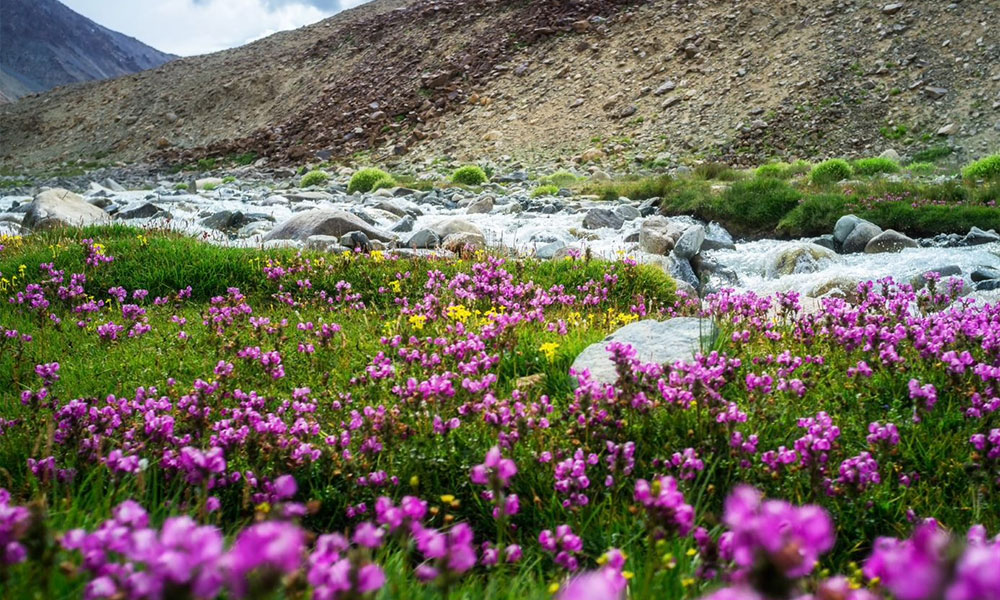Valley of Flowers National Park is located in the Western Himalaya, Uttarakhand. It is well known for its wide variety of flora and pastures of extensive alpine flowers. This flower-rich valley is also home to rare and endangered animals, like the red fox, the Asiatic black bear, musk deer, brown bear, snow leopard, and blue sheep. Apart from these animals, this national park is also a habitat of rare species of birds.
The Valley of Flowers is a high-altitude Himalayan valley and is located at approx. 3658 meters above sea level. Together, the mountain wilderness of Nanda Devi National Park and Valley of Flower National Park comprises a unique changeover zone between the mountain ranges of the Zanskar and Great Himalayas. The park covers an area of 8 km long and 2 km wide.
It has been well acknowledged by renowned botanists, mountaineers, and wildlife lovers. Even today Indian yogis love to visit this place for their meditation.
History of Valley of flowers
In the year 1931, three British mountaineers Frank S. Smythe, Eric Shipton, and R.L. Holdsworth, lost their way while returning from their expedition to Mt. Kamet and discovered the valley, which was full of flowers. They were enticed to the beauty of this valley and named it the "Valley of Flowers”.
Flowers found in Valley of Flowers
The Valley of Flowers has many different colourful flowers. Here is the list of flowers found in the valley of flowers.
Vajardanti, Potentilla atrisanguinea, Himalayan Cinquefoil.
Geranium Collinum, Pannier Soppu
Primula denticulata, Primrose, Drumstick Primula, Jalkutre
Thymus Linearis, Linear Leaved Thyme, Balma-jhar, Ban Ajwain
Indigofera Heterantha, Himalayan Indigo, Kathi, Kathoj, Sakina
Bistorta Affinis, Alteris Pauciflora,
Cypripedium Himalaicum, Himalayan Venus
Dactylorhiza Hatagirea, Hathageri, Paanch Anguli, Salaam Panja
Epilobium latifolium, River Beauty, Thalictrum Cultratum
Rosa Macrophylla, Wild Rose, Ban Gulab, Dand Kunja
Hyoscyamus Niger, Henbane, Bazer-Bhang, Dadura Ajavayan-Khurasani
Morina Longifolia, Biskanakara, Biskandru
Rhododendron Lepidotum, Typhonium Diversifolium
Aruncus Dioicus, Goat’s beard or Bride’s feathers
Colquhounia Coccinea, Himalayan Mint Shrub
Epilobium Laxum, Fragaria Nubicola, StrawBerry, Wild StrawBerry, Gand-Kaphal, Kiplaya, Badri
Impatiens Sulcata, Dog Flower, Chaul, Kwal, Rhodiola Wallichiana
Oxyura Digyna, Mountain Sorrel, Chyakulti, Kailashi
Polygonum Amplexicaule, Kutrya, Amli, Polygonum capitatum, Kaflya
Senecio Graciliflorus, Ground Sel, Kikret, Kuchee
Allium Wallichi, Doona, Gobka, Laddu, Bistorta Vaccinifolia, Inuri
Leycesteria Formosa, Himalayan Honey Suckle, Gulnar, Piralu
Spiranthes Sinensis, Phirlya, Vigna Vexillata, Machali
Corydalis Meifolia, Tongzil, Gymnadenia Orchids, Nepeta Erecta
How to reach the valley of flowers?
How to reach the valley of flowers by Road?
The closest route to reach the Valley of Flowers by road is Govind Ghat. It takes approx.11-12 hour drive to Joshimath from Dehradun, further require another one hour to reach Gobindghat. From Gobindghat it is an 8 miles (13 km) trek along a narrow, steep, and narrow mountain trail to the base camp at Ghangaria.
The total distance from Delhi to Valley of flowers is 508 km plus 13 km Trek from Pulna Village.
Best Route of the valley of flowers from Delhi - Delhi – Meerut – Haridwar – Rishikesh – Rudraprayag – Joshimath – Govindghat – Pula Village – Trek to the valley of flowers (13 km).
How to reach the valley of flowers by Train?
The nearest Railway station for the valley of flowers is Rishikesh. After that, you will have to go by road to Gobindghat. Distance from Rishikesh to Gobindghat is approx. 273 km. Frequent service of trains is available to Rishikesh.
How to reach the valley of flowers by Air?
The nearest airport to Valley of flowers is located in Dehradun. Daily flights are available from Delhi to Dehradun. You will have to cover a distance of 292 km till Govindghat from there you can start your trek of 13 km to the valley of flowers.
